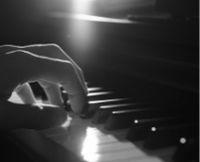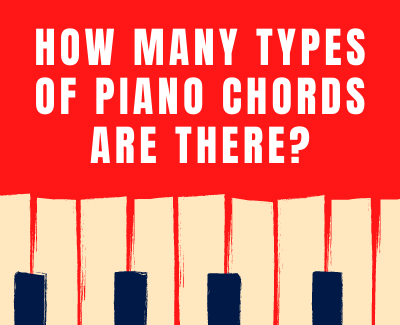Chords are also known as harmony. A chord is any harmonic collection of pitches/frequencies that consists of two or more notes (also known as pitches) played at the same time. Arpeggios and broken chords (in which the chord notes are sounded melodically rather than harmonically) may also be classified as chords.
There are 7 different types of piano chords. There are Major, minor, diminished, augmented, and suspended triads which are three note chords. In addition to triads, there are extended and altered chords as well.
These are generally classified chord types. If we take a look at the specifics of these chord types such as inversions, 9ths, 11ths, 7 sharp 9 etc. and the fact that each one of them can exist in 12 possible keys., then you’ll find that chords can number into the thousands.
Let’s take a look at some examples in these chord categories to make them simpler and easier to understand.
Major Triads
A Major triad consists of the 1st, 3rd, and 5th tones of a Major key of music. The Major triad is the predominant chord played in songs that are in Major keys. There are 12 Major triads in music.

Minor Triads
A minor triad consists of the 1st, 3rd, and 5th tones of a minor key of music. The minor triad is the predominant chord played in songs that are in minor keys. There are 12 Minor triads in music.

Diminished Triads
A diminished triad consists of the 1st, 3rd, and diminished 5th tones of a minor key of music. The diminished triad is often used as a passing chord to minor chords. There are 12 diminished triads in music.

Augmented Triads
An augmented triad consists of the 1st, 3rd, and augmented 5th tones of a Major key of music. The augmented triad is often used as a passing chord to Major or minor chords. There are 12 augmented triads in music.

Suspended Triads
An suspended triad consists of the 1st, 4th, and 5th tones of a Major key of music. Or, it will consist of the 1st, 2nd and 5th tones of a Major key of music. The suspended chord is often used to create tension and often resolves to a Major chord. There are 24 suspended triads in music counting suspended 4ths and suspended 2nds.


Extended Chords
Extended chords go beyond simple 3 note triads. They include one or more tones that extend the chord to 4 or more tones. Most of these extended tones are also known as color tones because they add color to what would be a simple triad without them.
7th Chords
There are several varieties of 7th chords. They each have their own character and harmonic function in music.
Major 7th Chords
The Major 7th chord consists of a Major triad with the 7th tone of a Major key of music added to it.

Dominant 7th Chord
The dominant 7th chord consists of a Major triad with the flatted 7th tone of a Major key of music added to it.

Minor 7th Chord
The minor 7th chord consists of a minor triad with the 7th tone of a minor key of music added to it.

Diminished 7th Chord
The diminished 7th chord consists of a diminished triad with a double flatted 7th tone of a Major key of music added to it.

Half Diminished 7th Chord
The half diminished 7th chord consists of a diminished triad with a flatted 7th tone of a Major key of music added to it.

Minor/Major 7th Chord
The minor/Major 7th chord consists of a minor triad with the Major 7th tone of a Major key of music added to it.

Beyond 7th chords
Chords that are beyond 7th chords include tones that are extended past the 7th tone of a Major or minor key of music. If you count past the octave note, the number sequence continues all the way to 13.

The tones that are included in extended chords are referred to as higher extensions. They always imply that there is either a flatted 7th tone or a Major 7th tone included in the chord.
9th Chords
The 9th chord consists of a Dominant 7th chord with the 9th tone of a Major key of music added to it.

The Major 9th chord consists of a Major 7 chord with the 9th tone of a Major key of music added to it.

11th Chords
The 11th chord consists of a Dominant 7th chord with the 11th tone of a Major key of music added to it. The 9th may or may not be included but either way, it would still be referred to as an 11th chord.
Be aware that the 3rd will very often be omitted because the 11th is only a half step away from the 3rd and these two tones clash. This chord also has a suspended quality to it which doesn’t include the 3rd.

13th Chords
The 13th chord consists of a Dominant 7th chord with the 13th tone of a Major key of music added to it. The 9th or 11th tone may or may not be included but either way, it would still be referred to as a 13th chord.

The Major 13 chord consists of a Major triad with the 9th and 13 tone added to it. The 9th tone may or may not be included but either way, it would still be referred to as a Major 13th chord.

Minor 9 Chords
The minor 9th chord consists of a minor 7th chord with the 9th tone of a minor key of music added to it.

Minor 11 Chords
The minor 11th chord consists of a minor 7th chord with the 11th tone of a minor key of music added to it. The 9th may or may not be included but either way, it would still be referred to as a minor 11th chord.

Minor 13th Chords
The minor 13th chord consists of a minor 7th chord with the 13th tone of a Major key of music added to it. The 9th or 11th tone may or may not be included but either way, it would still be referred to as a 13th chord.

6/9 Chords
A 6/9 chord is a special type of extended chord in which a 7th tone is not present. A 6/9 chord consists of a Major triad with the 6th and 9th tone of a Major key of music added to it.

Minor 6 Chords
A minor 6 chord consists of a minor chord with the 6th tone of a Major key of music added to it.

Altered Chords
Altered chords are extended chords of any variety that have either the 9th, 5th, or 11th tones raised or lowered a half step. A chord can have any combination of altered tones. Altered tones give extended chords a different quality.

Add Chords
Even though I did not include “add chords” into the chord categories, I do feel they should be mentioned. An add chord is one in which a tone is simply added to a Major or minor triad and the extended classification does not does not apply.
The most common added tones are the 2nd (also referred to as the 9th) and the 6th.


Omitted Tones
Just as tones can be added to a chord, they can also be omitted. This can apply to a simple triad all the way to an altered chord. The most common tone to omit in any chord is the 5th due to its consonance with the first tone.

My Final Thoughts
In this article I’ve covered the 7 different types of piano chords and chords that are somewhat out of a category that could include them. Be aware that these chords can be played in any Major/minor key.

This gives you 12 possibilities for each chord. Add to the fact that they can be played in virtually any inversion or voicing, and you will have thousands of possibilities. But don’t let this overwhelm you in the sense that you must learn these chords by rote memory.
Chords are learned by interacting with them and playing them in the context of music. Think of each type of chord as a person in which you would interact with and learn who they are so you would be familiar with them over time.
Be encouraged by the fact that when you learn one chord type in one key, it’s easier to learn in other keys because the structure is the same. Read about The 1% Rule in music. It explains how learning music gets easier.
Greg Lee
Latest posts by Greg Lee (see all)
- What is a minor/Major 7 Chord? - October 26, 2023
- 7 Chord Substitutions that Professionals Use - October 19, 2023
- 5 Simple Chord Tricks to Sound Amazing - October 5, 2023




